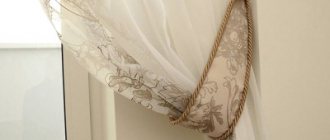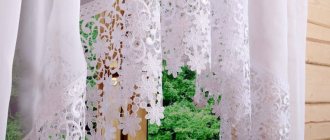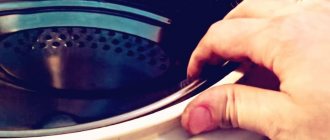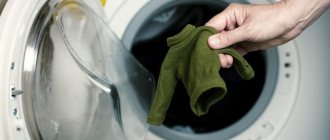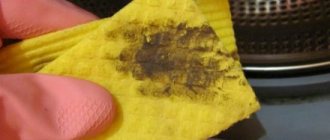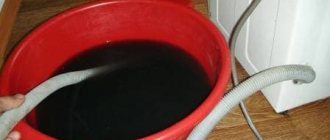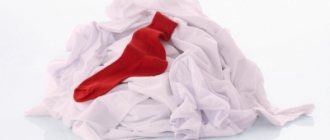Tulle is sewn from various fabrics, but always very soft and airy. Silk, viscose, polyester, nylon, cotton and even wool are suitable for such delicate work. Wool is woven into an openwork, thin veil.
Tulle made of nylon and polyester is considered the most durable. As for care, artificial fabrics are the best to wash, but this must be done very carefully - if the temperature is not maintained, the fabric turns yellow. Only delicate mode or hand washing will help.
Why did the tulle turn yellow or gray?
When you see that the curtains have lost their festive snow-white hue, you should not be upset. It is possible to return whiteness within 3–4 months. To decide how to bleach tulle, determine the type of material and establish the reason for the color change. Unpleasant color is caused by various factors:
- tobacco smoke;
- direct rays of the sun;
- ironing with a hot iron;
- proximity of heating devices;
- wash together with colored items;
- exhaust gases entering the apartment from the street;
- processing in hard or hot water;
- uneven rinsing, in which dust particles and grains of powder remain between the fibers.
Having established the cause of the contamination, it is easier to make the curtain white.
Kitchen curtains become dirty with soot and grease. Having determined the source of contamination, they decide how and with what to bleach the tulle from gray and yellowness.
Reference! Sometimes curtains made of organza, silk or muslin should be taken to the dry cleaner: at home it is difficult to remove dirty deposits from thin material. It is useless to try to remove old stains even with strong drugs. There is a risk of damaging textiles.
Causes of pollution
The appearance of the product deteriorates under the influence of certain factors.
- Dust and dirt - dust particles in the apartment, exhaust gases and sand from the street - all this settles on the window drapery and gives it a gray tint.
- The sun - due to active rays, the canvas acquires a yellow tint.
- Touching and other human factors - when we pull back the curtain, we leave a trace on it, albeit invisible to the naked eye. Gradually, an unsightly stain forms in this place. In the kitchen, drops of fat are added to this. The situation is even more complicated in a house where there are children: there is a possibility that paints, felt-tip pens, plasticine and other difficult-to-remove contaminants will get on the canvas.
Selecting a method
Young housewives sometimes do not know how to properly wash a tulle curtain. To wash away dirty deposits and remove stains, curtains are washed in a basin or in a machine with available products or substances for caring for fine fibers. Hand washing takes a lot of time. Automatic processing saves the housewife’s energy and time. In order not to spoil the material, return the white tint; the method, temperature and operating mode are chosen in accordance with the type of fiber.
Delicate fabrics require careful care
Keeping your home clean is part of taking care of your health.
A special element of home interior decor is tulle. White and colored, translucent, airy, smooth and patterned. The name tulle received in honor of one
of a new French city. Over time, many new materials and design solutions have appeared, but housewives prefer tulle. This fabric guarantees a free exchange of energy between the interior of the house and the external environment. The perfection of style and creative concept is emphasized by curtains, drapes and drapes. Our home is a living organism. Therefore, cleanliness is important to maintain a healthy atmosphere, mood and well-being. Keeping your home clean is part of taking care of your health. A tidy house is a center of comfort and warmth.
Snow-white tulle in the interior
Over time, snow-white products become gray, dull and dusty, acquire a yellowish tint, and fade. Dust settles on textile fabrics and stains appear. Regular care will remove unwanted dust, and washing will help remove dirt, return the canvases to an attractive appearance, restore freshness, and preserve the splendor of the products. This is not difficult to do, by observing the subtleties of keeping the house clean, you are showing sincere concern for the health of the inhabitants.
Handwash
If you know exactly how to wash a white tulle curtain by hand, even delicate organza, silk, and veil will not be damaged and will be cleaned. This is a gentle processing method in which the owner controls the process, regulates the force of influence on the canvas, preventing damage. Before washing tulle, select a washing liquid or powder and perform the following steps:
Preparing tulle
The product is removed from the cornice. Carefully shake out any dust accumulated between the threads. They try to deal with old stains before work: wash the stained area with a detergent, and wash it off after 3–40 minutes.
Additional Information! When washing by hand, avoid rough friction and the use of sponges and brushes. 10 - 15 minutes after soaking, the material is carefully squeezed and unclenched with your hands, and gently tapped.
Even dirty curtains need to be removed carefully and carefully.
Pre-soak
Pour lukewarm water into a large container and add gel or powder. Prepared items are placed in liquid. After 2–4 hours, if the textile is heavily soiled, replace the liquid with a new one. After soaking, the item is bleached. The treated curtains are rinsed twice to wash away any remaining powder and eliminate the odor. Dry flat, without squeezing: twisting causes holes and creases to appear. When the water has drained, the wet curtains are shaken and returned to the curtain rod.
Good to know, read: - The best and most effective ways to wash windows without streaks at home.
Reasons for yellowing of tulle curtains
There are several factors that influence the possible yellowing of curtains. Some of them can be excluded. White tulle turns very yellow from:
- sun exposure;
- cigarette smoke;
- grease and street dust;
- using unsuitable care products;
Improper care also causes this material to begin to turn yellow.
Care should include a pre-soaking step. To keep the tulle white, you need to wash it several times a year. If you neglect washing regularly, it will be difficult for the product to return to its decent appearance in the end.
Automatic wash
Wet cleaning in a machine will not spoil the structure of delicate fabrics if you set the mode correctly and choose detergents. Before you decide to wash a tulle curtain so that it is snow-white and clean, you should get acquainted with the algorithm of actions.
Preparing for whitening
The curtain removed from the cornice is freed from the hooks and cleaned of dust. Before automatic processing, the product is pre-soaked. To clean and bleach a tulle curtain at home, use a substance appropriate to the type of material. Delicate fabrics tolerate non-concentrated solutions of salt and soda.
Gels are rinsed out of delicate threads without leaving any traces
Choice of product
To wash tulle curtains at home until they are white, use oxygen-containing bleaches or products for cleaning white fabrics. The volume is calculated according to the instructions. It is prohibited to use preparations containing chlorine, since the element is potent:
- destroys delicate threads;
- provokes the appearance of a yellow-gray plaque;
- causes metal corrosion and destruction of rubber outlet pipes of the machine.
It’s useful to know, read: - How and with what to remove double-sided tape in 5 minutes from different surfaces.
Before washing the tulle, it is worth softening the water, otherwise scale microparticles will get stuck between the threads and give the curtains a gray tint. To do this, powders with a softening effect (Ariel, Persil), tablets or Calgon gel are added to the detergent. Folk remedies soften liquid and whiten textiles:
- lemon acid;
- soda;
- shavings of light laundry soap.
When cleaning dense material, add soda ash.
You can soften water using folk remedies
Washing bag
The curtains are straightened, carefully folded into a rectangle and placed in a calico pillowcase or a special bag made of heat-resistant mesh. The outer shell allows water and air to pass through, retains the shape of the curtain, and protects the thin fabric from the accidental appearance of puffs and pellets. The packaged product is placed in the drum of the machine.
Reference! Even when using a bag, curtains should not be washed together with clothes and other things.
Which mode to use
Thin tulle curtains can be washed in a gentle cycle, after turning off the spin cycle. Thick linen and cotton textiles are also cleaned in a delicate mode, but spinning is allowed at low speeds. Depending on the material, it is determined at what temperature tulle curtains should be washed. Airy organza, veil or jacquard are processed by setting the low temperature mode (+30 - 35℃). When caring for flax and cotton, the temperature is increased.
Delicate mode is best for tulle.
Types of bleaches
Bleaching agents for curtains and tulle are divided into three types depending on the composition of the components and the principle of operation.
Chlorine-containing
The composition includes sodium hypochlorite - an aggressive compound that penetrates deep into the fabric structure, destroying dirt and grease. The main advantage of chlorine-containing bleaches is their low price. However, chlorine is harmful to the respiratory system, causes burns upon contact with skin, and can lead to allergic reactions.
Another serious disadvantage of chlorine bleach is its short shelf life (up to 9 months). The product partially loses its properties due to exposure to direct sunlight and completely when frozen. Therefore, do not place a bottle of liquid on the balcony or in the basement during the cold season.
Chlorine-containing bleaches are completely unsuitable for bleaching tulle containing the following threads:
- silk;
- synthetic (polyester, polypropylene);
- nylon.
You will not wash nylon tulle, curtains made of tulle, chiffon, or organza with it. A reasonable question arises: what products can be bleached with a product containing chlorine? Only 100% cotton or linen tulle. Although they are found in houses and apartments, they are rare. In other cases, use other bleaches.
Chlorine products generally should not be used to bleach fabrics in the washing machine. It reacts with the metal trim of the drum and destroys the rubber outlet pipes.
Oxygen-containing
Available in the form of liquid concentrates and powders. Suitable for washing machine use. The composition includes hydrogen peroxide or sodium percarbonate, other additives - surfactants, fragrances. During washing, the active substance disintegrates, forming oxygen bubbles that oxidize gray plaque particles. The product does not leave an unpleasant odor on the curtains.
It is oxygen-containing bleach that is excellent for ridding curtains of gray plaque. On the packaging (bottle) of each product it is written which materials can be bleached with its help.
Optical
Contains particles with reflective properties. In fact, optical brighteners do not remove gray plaque, but mask it. But visually the tulle looks snow-white. As a rule, curtain washing products contain some percentage of optical brightener. The downside is the high price.
Features of bleaching depending on the material
To decide how to make a tulle curtain snow-white, check what material the product is made from, choose a cleaning method and bleach.
Capron
Before you start bleaching the nylon tulle, the curtain is kept in a saline solution for 45 minutes. To care for nylon, use chlorine-free preparations and home remedies:
- starch;
- brilliant green;
- blue;
- laundry soap.
Nylon is bleached in cool (+30 – 35℃) water manually or by machine, setting the delicate mode.
Additional Information! Soot and traces of grease are removed with dishwashing gel. Before wet treatment, the dirty area is lightly moistened with liquid, after 30 minutes it is washed off, and the item is washed.
Organza
Light fabric made from twisted polyester or silk fibers should not be roughly rubbed or pulled. Chemicals should not be used for whitening. Yellowness can be removed using the following means:
- light laundry soap;
- hydrogen peroxide;
- salt;
- blue;
- brilliant green.
Hand washing in cool (not higher than +35℃) water is acceptable. If you clean it in a machine, turn on the gentle program.
Special delicate approach to delicate fabrics
Batiste
Translucent fabric is woven from cotton or linen fibers. Thin textiles are resistant to high temperatures. To clean and lighten, it is permissible to boil with soap or pre-soak with starch solution or ammonia. Rinse by adding hydrogen peroxide.
Good to know, read: - 20 ways to remove traces of adhesive tape from plastic and other surfaces.
Veil
An airy veil made from cotton or silk threads must be taken care of carefully: the fibers are easily damaged. Hot water and substances containing chlorine are not used. Machine cleaning is acceptable if it is possible to set the speed to less than 400 rpm, a gentle program. Before loading into the drum, the item is carefully rolled up and placed in a mesh bag or pillowcase. You cannot wring out the veil.
With delicate products, the fabric looks like new for a long time
Kiseya
The fabric is made up of cotton, synthetic or silk threads woven together, into which beads, bugles or seed beads are woven. Needs careful but infrequent cleaning. The muslin is first soaked in starch liquid or hydrogen peroxide solution, then rinsed and washed with powder. Bleaching with ammonia after removing dirt in a powder solution.
Tulle mesh
The lightweight mesh fabric is created by weaving polyester threads and is therefore moderately durable. To keep it clean and snow-white, the curtain is dipped in a saline solution mixed with gel or washing powder. After 40 minutes, rinse.
Reference! Tulle can sometimes be treated with bleach. But if potent drugs are abused, the material will quickly lose its shine and strength.
Jacquard
The textile is woven from polyester, the weave of the fibers resembles lace. Jacquard fabrics look elegant and require careful handling. Therefore, soap, soda or mild chlorine-free products are used for bleaching. Machine wash only at low speed in cool water.
Many delicate fabrics are washed by hand
Chiffon curtains
Chiffon is a delicate material created from a mixture of cotton, synthetic and silk threads. On the surface of the canvas, puffs and pellets easily appear from a careless touch. The product is immersed in a cool soap-salt liquid until the components are completely dissolved. The washed item is not wrung out.
Tulle mesh
Dust and dirt particles accumulate in the cells. You should not pickyly choose how to bleach mesh tulle from gray: the mesh easily tolerates any bleaching compounds and processing methods. But twisting and squeezing are excluded in care: the structure of the delicate matter is quickly damaged.
It’s useful to know, read: - Simple ways to wash brilliant green in 5 minutes.
Linen tulle
Natural material is durable. Linen turns yellow in bright sun, but wears out from frequent cleaning. Before bleaching a yellowed linen tulle curtain, the item is dipped in a hot (45 - 50 ℃) washing solution. After 1.5 hours, rinse thoroughly, put in diluted ammonia or “Whiteness,” which refreshes the color of durable fiber if used rarely (once every 3 to 4 months).
Heat treatment and washing features of certain types of fabrics
| Material | Permissible processing temperature |
| Velours | 30 degrees |
| Viscose | 30 degrees |
| Acetate | 70 degrees |
| Polyamide | 40 degrees |
| Polyacrylic | 30 degrees |
| Polyester | 40 degrees |
Organza
Use in decoration
Thin and delicate fabric, perfectly transmits sunlight into the house, creates a uniquely amazing play of sunlight. What do owners of airy textile tulles and curtains need to know? Firstly, the hot, damp steam causes the fabric to become wavy; secondly, it does not tolerate contact with hot water; thirdly, the use of industrial bleach is not advisable; fourthly, excellent cleaning results can be achieved using affordable, proven methods. Bleaching of organza will be ensured by initial soaking in salt water, ammonia, adding hydrogen peroxide (two tablespoons of peroxide, one tablespoon of ammonia, five liters of water), starch.
Capron
The sparkling whiteness of nylon
Ultra-strong, wear-resistant artificial material. It looks decorative and does not get dirty for a long time. Does not require ironing. Clean nylon in non-hot water. It easily tolerates the delicate washing regime. Of the above bleaching agents, we recommend green, blue or potassium permanganate, a solution with salt and a starch solution during washing and rinsing.
Chiffon
Noble beauty
Curtains made of chiffon fabric look sophisticated and noble. They should be washed by hand, observing the temperature and choosing a suitable detergent. When resorting to bleaching, use the following recipe: dilute 2 tablespoons of hydrogen peroxide and 1 tablespoon of ammonia in 10 liters of warm water. Place the cleaned item in the mixture for 20–30 minutes. Rinse.
Veil
Delicate textiles
To produce a veil, wool, cotton, silk or polyester yarn are used. It looks elegant and sophisticated in the interior, but fades over time. The industry offers white, dyed and printed fabric. Sometimes embroidery decorates the front side. A design is created through printing or chemical etching. Then the material combines two types of fibers. The veil requires hand or gentle machine wash at a temperature of no more than 30 degrees. It is not recommended to use chlorine-containing bleaches. Iron at moderate temperature using a cloth pad. Avoid dry cleaning. An aqueous solution of peroxide and ammonia will help restore the whiteness.
Taffeta
Iridescent shine
Products on the consumer market are made from synthetic or natural ingredients. The structure of the fabric is dense and rigid. Has a characteristic iridescent shine. The fabric, processed in a special way, acquires the properties of a chameleon and changes shade depending on the viewing angle. For taffeta products, hand washing is practiced at 30 degrees with a mild detergent. Beware: twisting leads to deformation of the fabric; folds cannot be smoothed out even with ironing.
Cotton
Cotton curtain
The production of cotton products is based on environmentally friendly raw materials. The undoubted advantage and advantage of cotton is its ability to “breathe”, allow air to pass through, and is hypoallergenic. Not picky about washing, especially 100% natural threads without synthetics. The permissible temperature is up to 60 degrees; the use of oxygen bleaches and some chlorine-containing bleaches for white fabrics is allowed. High spin speeds are normal. Drying in a machine is used only for those things where there is a manufacturer’s recommendation. You can restore the dazzling snow-whiteness of grayed, yellowish tulle by soaking it in salt water before the main wash (2 tablespoons of salt per 2 liters of water). The maximum permissible exposure temperature is 40–45 degrees.
Nylon
Use in room design
Man-made fiber, 100% man-made, made from synthetic threads, soft and easy to drape. Easily erased. It is easy to care for, but be sure to take into account some subtleties.
- Decorate rooms where there is no direct sunlight, which causes nylon to fade.
- Consider the previous recommendations for washing synthetic items (especially temperature conditions).
- Avoid using products that contain chlorine or bleach.
- Wash white items separately from colored items.
- Add blue when rinsing and this will improve the shade of light-colored fabrics and refresh them.
- Do not leave it in the car after cleaning: after completing the process, remove it.
- Avoid using automatic drying.
- Do not dry near heating appliances.
Silk
Graceful beauty
Silk curtains and drapes look great and will decorate any interior. Taking care of their durability and safety, wash by hand with liquid detergent or using dishwashing balm at a temperature of about 30 degrees. Do not spin in a centrifuge. Avoid drying in direct sun and near radiators. It is recommended to dry in the shade.
Linen
Linen curtains are made from natural materials, are environmentally friendly, hypoallergenic, practical and elegant, giving comfort. Considering the special advantages of textiles, they enjoy well-deserved recognition among designers and customers. Easy to care for, durable, soft. If you do not wash them at high temperatures, they will protect the comfort of your home for a long time, because they are considered one of the most unpretentious. Do not overdry, iron the curtains slightly damp with a hot iron.
Roman curtain
How to return whiteness to old tulle
It is difficult, but possible, to return the original whiteness to old tulle. We need radical, comprehensive measures that can revive the lost attractive appearance and beauty of tulle, “bring it back to life.”
- Pre-soak in saline solution.
- Wash with special detergents for washing curtains.
- Use oxygenated bleach with synthetic detergents added.
- Boil tulle made from natural fibers - boil for 40 minutes - 1 hour in a strong soap solution.
- Soak in hydrogen peroxide solution, rinse with clean water.
- Rinse in a simple saline solution.
- Secure the effect by rinsing in lukewarm water with the addition of 200 grams of starch.
There is a common misconception among inexperienced housewives that soiled tulle should be bleached as soon as it is removed from the window. If you do this, the dust will thoroughly and firmly attach itself deep into the structure of the fabric, turning it into an unsightly, unpleasant gray color. Washing dirty tulle immediately at high temperatures will also lead to “welding” of dust particles to the fibers.
How to make tulle white using improvised means
Ordinary substances will help restore lost whiteness. Such products are hypoallergenic, effective, and affordable.
Salt
The use of these products requires soaking.
To cleanse dirt and bleach, tulle curtains are soaked in dissolved sodium chloride (for 5 liters - ¼ cup each of washing gel and salt). After 8-10 hours, rinse and wash using the usual method.
Additional Information! If you soak very dirty curtains twice (the first time in dissolved sodium chloride, the second time you add gel), you will be able to wash off even old grease.
Aspirin
The gray coating will disappear from the fabric after soaking in dissolved aspirin (take 5 tablets for 6 liters of lukewarm water). The textiles are cleaned of dust, placed in a basin, and filled with washing liquid. After 3 hours, wash.
Soda
An alkaline solution easily removes dirt and restores the original color of even old fabric. To prepare the detergent composition, stir 30 g of sodium bicarbonate and the same amount of powder into 10 liters. An hour after soaking, the curtains are washed in a machine or by hand. Curtains made of linen or cotton are treated with soda ash, veil, organza, chiffon - only food grade.
Reference! Remove the dirty gray coating and bleach the tulle with a mixture of salt and soda: take 7 tbsp for 10 liters. spoons of alkali, 9 tbsp. spoons of rock salt. The curtains, cleaned of dust, are kept in the prepared composition for 1.5 hours, then washed thoroughly. Wash with gel or soap.
Boric acid
Folk remedies will help remove grayness and yellowness.
The drug can bleach old nylon tulle, covered with a gray coating and yellow spots. It is easy to verify the effectiveness of the method; to do this, follow these steps:
- 30 ml of boric acid is diluted in five liters of warm liquid;
- curtains are soaked for 3 hours;
- rinse.
The product, which has regained its lost snow-whiteness, is straightened. Dry in a shaded place.
Useful to know, we recommend reading: What to do if a mercury thermometer breaks at home and mercury leaks out?
Vinegar
Table vinegar removes grayness and eliminates unpleasant odors embedded in the fibers. The curtains are dipped in a lukewarm salt-vinegar solution for 3 hours (the ingredients are taken in equal parts), then washed and dried.
Ammonia
Before bleaching tulle curtains with ammonia, the item is washed and then immersed in an unsaturated ammonia solution for 1.5 hours. After bleaching, rinse.
Additional Information! If dirt has become embedded in the thin fibers, ammonia is combined with 30 ml of hydrogen peroxide. In this way, soot and grease are quickly removed, and even old tulle that hangs in the kitchen is lightened.
Lemon acid
Dry matter or juice is added during the final rinse. Before this, the curtains are cleaned with white soap and lightened with peroxide. The washed curtains are kept in dissolved citric acid. After 15 minutes, carefully squeeze out without twisting.
Citric acid whitens and removes rust marks
Hydrogen peroxide
Hydrogen peroxide is a strong bleach that helps restore the whiteness of delicate tulle items. The curtain is placed in a capacious container, filled with diluted clarifier (4 tablespoons of the drug are used for 12 liters). After 4 hours, rinse.
Potassium permangantsovka
Restore the snow-white shade, remove stains and stains with a pale pink solution of potassium permanganate. The crystals are diluted in a transparent container and combined with shavings of light laundry soap. Stir and pour into a bowl of warm water. The curtains are soaked in foamy liquid for 3 - 4 hours.
Blue
Contaminated tulle can be cleaned in a washing machine or by hand. The washed curtain is placed in diluted blue for 25 - 30 minutes to remove the gray-yellow coating. The new soft blue shade will give the item an updated look.
Reference! When using dyes - blue, brilliant green - follow the dosage recommended by the manufacturer, monitor the saturation of the liquid, otherwise the curtains will acquire an undesirable color.
Zelenka
The yellowness will disappear from nylon and tulle after soaking in a saline solution with brilliant green. A bleaching agent is prepared from the following components:
- 0.5 liters of water;
- 4 table. spoons of salt;
- 20 drops of greenery.
The ingredients are thoroughly mixed, then diluted with water. The pre-washed curtain is immersed in a liquid greenish composition. After 15 minutes, the item is hung on a rope.
Laundry soap
Light laundry soap will return the yellowed product to its purity and snow-white tone. To do this, pour 0.1 kg of washing powder and 0.15 kg of soap shavings into a basin of heated water. The components are stirred until completely dissolved. The textiles are kept in the liquid mixture for 2 hours, turning occasionally. After treatment, wash. The final stage of cleaning is a gentle machine wash.
Additional Information! Curtains made from artificial fibers should not be cleaned with soap: the fabric irrevocably loses its shine.
Wash only with white soap
Starch
Starched curtains look elegant. Starch enhances the density of natural materials and repels dust particles. To make the fabric on the window gather into elegant folds, make a weak paste:
- First, the dry substance is dissolved and put on fire.
- Stirring constantly, bring to a boil.
- The boiling paste is poured into cold water.
- Breaks up lumps.
- The canvas is immersed in the prepared paste. They wait for the material to be thoroughly saturated with starch.
- Lightly squeeze and dry.
Wet curtains are carefully ironed.
Special products for washing tulle
Curtains can be put in order not only with the help of home remedies, but also with the help of special purchased ones. The best products that return curtains to their original appearance:
FRAU SCHMIDT SUPER WHITE TULLE
"Super White Tulle" is a bleaching agent in the form of tablets that enhances the effect of the powder, designed specifically to restore the snow-whiteness of curtains. The instructions tell you how to bleach tulle with this product.
Directly into the drum of the washing machine you need to put the product at the rate of 1 tablet for the maximum drum load of three kilograms. Accordingly, if the drum load is 6 kilograms or more, then you need to put 2 tablets.
The curtains are placed in the drum and the washing powder is placed in the detergent dispenser. The amount of powder is taken in accordance with the recommendations of its manufacturer.
Curtains are washed at a temperature of 30 degrees in the “delicate”, “curtain washing” and similar modes. If necessary, you can turn on an additional rinse. Using Frau Schmidt's product is a quick way to restore them to a decent appearance and their former cleanliness.
SPLASH FOR TULLE FROM GENERAL FRESH
Another special product produced by the Polish company General Fresh, “Splash-bleach for tulle,” will help in solving the question of “how to wash tulle from grayness.” This bleach can be used both during hand washing and during machine washing. After washing the curtains by hand, you need to lower them several times into a container of water in which 30 grams of bleach have previously been dissolved.
When machine washing, the manufacturer recommends adding the product during the last rinse. Not all machine models have the option of adding the product during washing or during the last rinse, so it is more advisable to add the product after the cycle is completed and start rinsing.
Reviews for this product are positive. Everyone who used Splash noted that the desired effect was achieved without much time or physical effort.
Elixir for tulle and curtains “CASHMERE”
A bleach with similar properties and composition, including optical brightener, as the previously listed special products.
“Cashmere” is intended for bleaching specifically various tulles, curtains, curtains, especially kitchen ones. It can be used for soaking and hand washing (add 10-15 grams of product per 10 liters of water), as well as in washing machines (add 90 to 110 grams for every 2-2.5 kilograms of dry laundry).
The manufacturer not only placed recommendations on the use of this product on the packaging, he also placed some useful tips on washing rules, for example, washing temperature conditions.
Digestion
If washing the tulle did not help cope with yellowing, grandmothers and mothers boiled the curtains:
- they took a large enamel basin or bucket;
- water was poured into the container, soap shavings or powder were poured in;
- the product was placed into the liquid foam mixture;
- the container was placed on fire;
- after boiling, heated for an hour over medium heat, turning occasionally (the material was grabbed with metal tongs).
Curtains made from cotton fibers will become snow-white again after boiling.
Modern types of textiles add artificial fibers that require careful care. With prolonged boiling, delicate threads quickly melt and the fibers become deformed. Curtains made of organza, chiffon or nylon cannot be boiled. Curtains made from thick natural fabrics are sometimes boiled down, although the housewife has to control the process and should not leave the stove often.
Reference! If cotton textiles have turned yellow and dirty, the item is first boiled and then soaked in peroxide. If the dirty color remains, the fabric is kept in salted liquid, then rinsed and starched. Often this method should not be used: after 2–3 treatments, the fabric will become thinner and irrevocably lose its snow-white color.
Composition with hydrogen peroxide, potassium permanganate and brilliant green, proportions, instructions
Few people know, but a good bleach that removes yellowing is potassium permanganate. Instructions for use:
- mix potassium permanganate and pre-grated laundry soap (it is advisable to use 72%);
- Mix the mixture with soap in warm water;
- pour dissolved potassium permanganate into the container (there should be no sediment);
- the result is pink, foamy water.
Another method of combating stains and grayness of tulle material is bleaching with potassium permanganate.
Keep the curtains in the solution in the container for 30 minutes. Next, you need to wash it using the usual method - automatically or by hand. As a result, the unpleasant gray tint will completely disappear, and very little time was spent. there is a small drawback: finding potassium permanganate can be problematic.
It is very important that the color of the water turns pink and not purple.
Hydrogen peroxide is also a good way to combat yellowed fabric. You can soak the curtains overnight by pouring a bottle of peroxide into a bowl of water.
Soaking tulle in hydrogen peroxide.
It is recommended to rinse the product in the morning. If there is no time for soaking, a washing machine will come to the rescue - pour powder and peroxide into the conditioner compartment.
Wash in “delicate” mode.
How to make fabric turn white using household chemicals
Most older generation bleaches contain chlorine. This element disinfects and brightens quickly, but aggressively - along with the yellowness, the structure of the fibers is destroyed. Such products should be used rarely, only for dense natural materials. To care for a veil, cambric, jacquard, choose chlorine-free compounds that act gently:
- Oxygen preparations containing sodium bicarbonate, hydrogen peroxide. When interacting with water, they release oxygen. Eliminate dirt, foreign odors and quickly exhibit whitening properties without disturbing the structure of the threads. The grayish-yellow coating returns after 2 - 3 weeks, but such compositions can be used regularly for washing curtains.
- Synthetic and natural materials are treated with optical brighteners. Powders remove dirt and lighten dark stains. Reflective microparticles do not eliminate, but hide the gray-yellow coating, so the curtains appear snow-white for 3-4 weeks.
Before washing the tulle, dissolve the detergent according to the instructions. Chemical mixtures act intensively even in cool water. Textiles are placed in the prepared bleaching medium. If using a machine, the clarifier and powder are poured into a special compartment. The washed item is rinsed and hung out to dry.
White
The clarifier is 95% chlorine. Causes allergic reactions. When working, wear gloves and open windows. The active ingredient removes yellowish circles, destroys dirty gray tint, and disinfects at +30℃. It is used for the care of linen and cotton curtains, for cleaning organza; muslin is not used, because the aggressive element thins the threads. Leave the curtains in the diluted mixture for 30 minutes before final cleaning.
Whiteness destroys delicate fabrics
Additional Information! After 1 – 2 soakings in “Whiteness”, the matter gets used to the active component and stops reacting to oxygen bleaches.
Wellery delicate white washing gel
Gently lightens cotton and synthetic fabrics. Contains optical brightening microparticles and enzymes. The hypoallergenic gel returns the snow-white appearance of curtains using any cleaning method, although it cannot cope with old dark stains, stubborn dirt and grayness. Dissolves in hot and cold water. Smells nice. Easily washed out.
Chirton oxygen bleach stain remover
Fragrant particles cleanse dirt and remove even old stains from berries, soot, and grease on curtains made of cotton and synthetic fabric. Chirton oxygen is considered one of the best effective drugs that restore the lost snow-whiteness of canvases. Enhances the effectiveness of gels. Intensively whitens at any temperature.
Other means
Similar preparations are used to bleach tulle curtains.
Bleaching preparations are selected for delicate threads
Frau Schmidt
Whitening tablets are designed for the care of delicate textiles. The packaging is designed for 5 wet treatments. Optical and oxygen-containing elements, enzymes destroy stubborn dirty stains even in hard and cool (+30℃) water. Does not cause allergies.
Cashmere
Small granules with optical brightening microparticles for the care of delicate natural and artificial fabrics. The yellowed fabric is soaked and cleaned in a warm solution. Removes nicotine film and yellowed greasy stains. Removes gray plaque from kitchen curtains.
Dr. Beckmann
Oxygen-containing sachets for machine cleaning of cotton and artificial fibers. The concentrated substance whitens, eliminates foreign odors, removes dust, soot and greasy stains at +20℃. Effectiveness increases when heated. Portion bags (0.08 g) are placed together with the item in the machine drum.
Optical brighteners are used for silk
Freshbubble
Oxygen stain remover with brightening properties. Without boiling, it removes contaminants of natural and inorganic origin. The granules do not contain chlorine. Effectiveness increases at temperatures from +50℃.
Splash
An oxygen-containing brightener with optical elements designed for wet processing of delicate curtains made of nylon, cotton and linen. Splash is conveniently packaged in 30 gram bags. The packaging is designed for one use. Pre-washed curtains are immersed in dissolved powder for 0.5 hours, then rinsed thoroughly.
Clean home
Oxygen microgranules with an optical brightening component are used for soaking and washing. One spoon of small granules eliminates fresh streaks and bright stains. To wash away old circles, double the dose.
Reference! Silk curtains are treated with special powders: Laska 3D wool and silk, Unipuls, Organic People.
What to do if tulle fabric shrinks after washing
Items made from natural materials are most prone to shrinkage. As a rule, this is a consequence of high temperature or the wrong choice of cleaning agents. Linen and cotton, as representatives of natural fabrics, are at risk. Shrinkage and shrinkage occur due to incorrect temperature conditions or incorrect choice of washing agent. Therefore, carefully read the instructions first and take into account the restrictions on use. If trouble does occur, ordinary hydrogen peroxide will help correct the situation: dilute 20–30 ml of the drug in 10 liters of cold water. Thoroughly rinse the shrunken item in the solution, while actively straightening the deformed areas. Rinsing with conditioner is also an effective technique.
How to remove stains
Thin transparent fabrics quickly turn yellow and gather dust. It is difficult to maintain freshness in the kitchen and keep the linens clean, even if a powerful hood is installed. Therefore, housewives are interested in how to wash tulle and remove the difficult-to-remove yellowish tint.
Rust
To remove rust stains from cambric, muslin or chiffon, the products must be dry-cleaned. At home, red spots are removed from thick cotton curtains using organic acids:
- vinegar;
- oxaline;
- lemon;
- wine
Warm water and 0.02 g of acid are mixed in a glass container. The dirty fragment is immersed in an acidic environment. After 15 minutes, the area is washed in a liquid mixture of ammonia and soda. This is repeated until the circles disappear.
Fat
Fresh splashes are removed using the following methods:
- The curtain is soaked in a soda solution. After 2.5 hours, wash with soap suds.
- The spot is sprinkled with crushed chalk. When the white particles absorb the fat, the chalk is cleaned off and a new layer is added (this is repeated until the dirt disappears).
- The fatty fragment is carefully washed with dishwashing liquid.
Old grease stains are washed off with a combination of vinegar, salt and ammonia. The components, taken in a ratio of 4:1:4, are applied to the damaged surface. After 20 minutes, the fabric is washed with liquid soap.
Additional Information! Stains are removed by moving from the contaminated periphery to the center.
Mold
A fungus that has grown on the curtains disrupts the structure of the threads and smells unpleasant. It is difficult to fight mold at home, but it is worth trying to remove a stain on dense material. The fungus is destroyed with citric acid or vinegar. First, the curtains are washed with soap or powder. Remains of detergents are washed off. The damaged area is watered with vinegar (lemon juice), and after 1.5 hours, sprinkled with salt. After the layer has dried, the material is rinsed.
Home remedies remove traces of dirt and whiten
Thin fabrics with decor require careful cleaning. It is difficult to remove grayness using improvised means: dirty stains often remain and textiles are damaged. Therefore, to clean a veil, chiffon or jacquard, you should contact a dry cleaner.
Reference! It is easier to remove stains if the product is soaked in an alkaline solution for 2 hours. The liquid will soften the dirt, wash away yellow circles and a grayish tint. Washing after pre-soaking will seal the effect of the soda.
Boiling method for gray and yellowed fabric
Boiling or boiling fabric is an ancient bleaching method that was successfully used at the beginning of the last century. But today, windows are draped with delicate fabrics that under no circumstances should even be washed in hot water.
The boiling method is only suitable for cotton fabrics.
- Heat water to a boil (about 8-10 liters) and add a glass of soap shavings to it.
- Stir well so that there are no lumps left in the water, and then place the wet tulle into the solution.
IMPORTANT: the tulle must first be soaked in washing powder with soda and salt.
- The product should be boiled for an hour, stirring every 10 minutes.
- Then cool a little and rinse thoroughly; you can add a few drops of blue to the rinsing water.
Cotton tulle can be boiled and bleached using any folk remedies and household chemicals. The only thing is to make sure that there is no chlorine in the bleach, as it strongly destroys the fabric.
How to carefully bleach old tulle from gray plaque and yellowness
The fibers of old curtains are thin and saturated with dust. Due to friction and exposure to bleaches, textiles can tear before they have time to turn white. Therefore, old yellow stains are removed carefully:
- before washing old tulle curtains from gray, carefully clean the item by hand or using a machine (set to delicate mode, turn off spin);
- washed curtains are soaked in a mixture of peroxide and ammonia;
- rinse and dry.
Linen or cotton fabric that can withstand high temperatures is boiled with powder or soap.
Additional Information! Synthetics are returned to white with vinegar. Add 2 tablespoons to 5 liters of cool water. l. acids. The curtain is carefully placed in an acidic medium and stirred periodically. After 3 hours, rinse.
Whitening tulle with ammonia, instructions on how to wash
How can you bleach gray or yellowed tulle using ammonia? The best way to bleach is with ammonia, or rather, a mixture of ammonia, hydrogen peroxide and drinking water. It is important to observe the proportions: for 10 liters of water, use 1 tbsp. l. alcohol and 2 tbsp. l. peroxide. The components are mixed, and the curtain is immersed in the container with it.
This method should only be used for bleaching cotton materials.
IMPORTANT! To avoid yellow streaks remaining on the fabric, immerse the nylon completely in the liquid!
In order for bleaching to occur evenly, you need to periodically turn the contents. After half an hour, pull out the tulle and rinse thoroughly with running water, carefully hang it over its entire length. If you don’t have time to soak, take advantage of modern technology: wash your curtains with the same bleaching agent instead of conditioner, on a delicate cycle. You can go the simple route - throw about 10 peroxide tablets.
The temperature should not exceed 40 degrees.
If you do not have the ingredients to prepare the above mixture, you can dilute pure ammonia with 5 liters of heated water. Soak for about half an hour, rinse.
You can perform this manipulation after each scheduled wash, even for new tulle.
Rules for drying and ironing
Wide canvases are difficult to care for. It is inconvenient to wash by hand in a standard container. When cleaning by machine, you have to check what speed and how many degrees are indicated on the panel. Be careful when drying and ironing, otherwise the textile will deform or melt.
Delicate material is ironed with a low-heat iron
Advice from experienced housewives will make your work easier and help you understand how to wash a tulle curtain without ironing:
- in the washing machine set the program without spin;
- When washing by hand, do not twist or wring out the fabric;
- the curtain is transferred to a dry basin and waited for it to dry slightly;
- The straightened product is dried on a ledge.
After 40 minutes, the curtain will finally dry out and, under the influence of its own gravity, straighten out. Small folds and creases that remain on a damp surface are steamed by weight or ironed through a double layer of gauze.
Tulle needs to be washed every 3 months, otherwise transparent curtains will become covered with yellowness or a layer of gray dust. Aggressive lighteners destroy delicate threads. If you regularly use delicate oxygen-containing preparations and use home recipes, the curtains will not be damaged, and the whiteness will remain for a long time.
Preparing for whitening
So, you've decided to dedicate the day to turning your curtains into new ones.
Carefully remove them and shake them thoroughly to remove any accumulated dust. To soak the product, take a large container and carefully fold the curtains to avoid unnecessary creases and not spoil the structure of the fabric.
You need to soak the tulle in lukewarm water, no more than 35 degrees. Pour two tablespoons of soda and a little powder into the water; experienced housewives recommend using “Persol”. Two hours of soaking is enough. After that, remove the fabric from the water, gently wring it out and proceed to washing.
How to bleach tulle
Ready-made and folk remedies are suitable for washing and bleaching. The first are industrial oxygen-based bleaches. Suitable for most delicate fabrics. Oxygen bleach removes yellow stains, removes stains, and gets rid of gray color. Add to soaking water according to instructions. It is better to use liquid bleach: it dissolves more easily and is washed out of any fabric.
It is better to soak delicate fabrics with gentle home remedies:
- Nylon tulle is bleached with hydrogen peroxide, salted water or brilliant green.
- Cotton can be washed with soap and soaked in starch.
- The organza will turn white when exposed to ammonia and peroxide.
- Flax will withstand boiling with soap shavings. It bleaches well with ammonia.
- The veil cannot be “poisoned” with household chemicals. Starch or ammonia are suitable for bleaching.
It is not recommended to use “Belizna” and other chlorine-containing products. Chlorine will corrode fine fibers. Cotton can be washed occasionally.
How to bleach organza from gray
